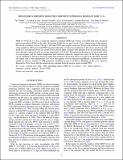HIGH-ENERGY EMISSION FROM THE COMPOSITE SUPERNOVA REMNANT MSH 15-56
Author(s)
Temim, Tea; Slane, Patrick; Castro, Daniel; Plucinsky, Paul P.; Gelfand, Joseph D.; Dickel, John R.; ... Show more Show less
DownloadTemim-2013-High-energy emission.pdf (1.300Mb)
PUBLISHER_POLICY
Publisher Policy
Article is made available in accordance with the publisher's policy and may be subject to US copyright law. Please refer to the publisher's site for terms of use.
Terms of use
Metadata
Show full item recordAbstract
MSH 15-56 (G326.3–1.8) is a composite supernova remnant (SNR) that consists of an SNR shell and a displaced pulsar wind nebula (PWN) in the radio. We present XMM-Newton and Chandra X-ray observations of the remnant that reveal a compact source at the tip of the radio PWN and complex structures that provide evidence for mixing of the supernova (SN) ejecta with PWN material following a reverse shock interaction. The X-ray spectra are well fitted by a non-thermal power-law model whose photon index steepens with distance from the presumed pulsar, and a thermal component with an average temperature of 0.55 keV. The enhanced abundances of silicon and sulfur in some regions, and the similar temperature and ionization timescale, suggest that much of the X-ray emission can be attributed to SN ejecta that have either been heated by the reverse shock or swept up by the PWN. We find one region with a lower temperature of 0.3 keV that appears to be in ionization equilibrium. Assuming the Sedov model, we derive a number of SNR properties, including an age of 16,500 yr. Modeling of the γ-ray emission detected by Fermi shows that the emission may originate from the reverse shock-crushed PWN.
Date issued
2013-04Department
MIT Kavli Institute for Astrophysics and Space ResearchJournal
Astrophysical Journal
Publisher
IOP Publishing
Citation
Temim, Tea, Patrick Slane, Daniel Castro, Paul P. Plucinsky, Joseph Gelfand, and John R. Dickel. “ HIGH-ENERGY EMISSION FROM THE COMPOSITE SUPERNOVA REMNANT MSH 15-5 6 .” The Astrophysical Journal 768, no. 1 (April 15, 2013): 61. © 2013 The American Astronomical Society
Version: Final published version
ISSN
0004-637X
1538-4357